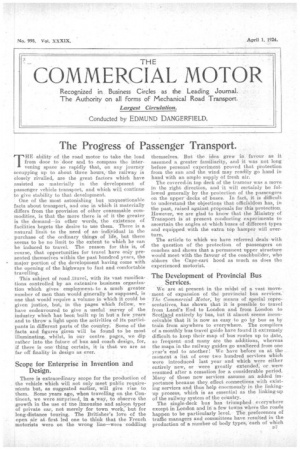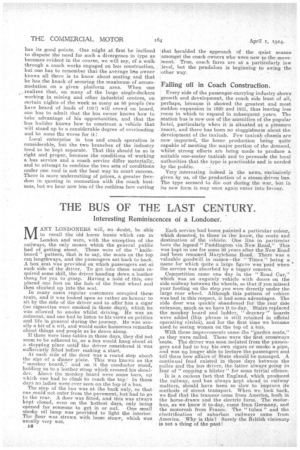The Progress of Passenger Transport.
Page 1

Page 2

If you've noticed an error in this article please click here to report it so we can fix it.
THE ability of the road motor to take the load from door to door and to compass the intervening space so rapidly that, on any journey occupying up to about three hours,the railway is closely rivalled, are the great factors which have assisted so materially in the development of passenger vehicle transport, and which will continue to give stability to that development.
One of the most astonishing but unquestionable facts about transport, and one in which it materially differs from the provision of other consumable commodities, is that the more there is of it the greater is the demand—in other words, the existence of facilities begets the desire to use them. There is a natural limit to the need of anindividual in the purchase of the ordinary things of life, but there seems to be no limit to the extent tO which he can be induced to travel. The reason for this is, of course, that opportunities for travel have only presented themselves within the past hundred years, the . major portion of the development having come with the opening of the highways to fast and comfortable travelling.
This subject of road ;travel, with its vast ramifications controlled by an extensive business organization which gives employmentto a much greater number of men than would generally be supposed, is one that -would require a volume in which it could be given justice, but, in the pages which. follow, we have endeavoured to give a useful survey of the industry which has been built up in but a few years and to throw a light upon the activities of its participants in different parts of the country:. Some of facts. and figures given will be found to be most illuminating, whilst., in our centre pages,, we dip rather into the future of bus and coach design, for, if there is one thing certain, it is that we are as far off finality in design as ever.
Scope for Enterprise in Invention and Design.
There is extraordinary scope for the production of the vehicle which will not only meet public requireMents but, as suggested earlier, will give rise to them. Some years ago, when travelling on the Continent, we were surprised, in a way, to observe the growth in the use of the limousine and saloon typer of private car, not merely for town work,but for long-distance touring. The Britisher'a love of the open air at first led one to think that the French motorists were on the wrong line—were coddling themselves. But the idea grew in favour as it assumed a greater familiarity, and it was not long before personal experiment proved that protection from the sun and the wind may readily go hand in hand with an ample supply of fresh air.
The covered-in top deck of the tramcar was a move in the right direction, and it will certainly be followed generally by the protection of the passengers on the upperdecks of buses. In fact, it is difficult to understand the objections that officialdom has, in the past, raised against proposals for this protection. However, we are glad to know that the Ministry of Transport is at present conducting experiments to ascertain the angles at which buses of different types and equipped with the extra top hamper will overturn.
The article to which we have referred deals with the question of the protection of passengers on coaches and shows that a permanent upper structure would meet with the favour of the coachbuilder, who abhors the Cape-cart hood as much as does the experienced motorist.
The Development of Provincial Bus Services.
We are at present in the midst of a vast movement of expansion of the' provincial bus services. The Commercial Motor, by means of special representatives, has shown that it is possible to travel from Land's End to London and from London to Scotland entirely by bus, but it almost seems inconceivable that it is now as easy to go by bus as by train from anywhere to everywhere. The compilers of a Monthly bus travel guide have found it extremely difficult to keep their map of bus routes up to date, .so frequent and many are the additions, whereas the maps in the railway guides go unaltered from one year's end to another ! We have before us at the . moment 'a list of over two hundred services which were introduced last year and which were either entirely new, or were greatly extended, or were resumed after a cessation for a considerable period. Many of these new services assume an added importance because they effect connections with existing services and thus help enormously in the linkingup process, which is as essential as the linking-up of the railway system of the country. . The single-deck bus has triumphed everywhere except in London and in a few towns where the roads happen to be particularly level. The preferences of traffic managers and committees have resulted in the production of a number of body types, -each of which has its good points. One might at first be inclined to dispute the need for such a divergence in type as becomes evident in the course, we will say, of a walk through a coach works engaged on bus construction, but one has to remember that the average lofts owner knows all there is to know about seating and that he has the knack of securing the maximum of accommodation on a given platform area. When one realizes that, on many of the large single-deckers working in mining and other industrial centres, on certain nights of the week as many as 80 people (we have heard of loads of 100!) will crowd on board, one has to admit that the bus owner knows how to take advantage of his opportunities, and that the bus builder knows how to construct a vehicle that will stand up to a considerable degree of overloading and be none the worse for it !
Local enterprise in bus and coach operation is considerable, but the two branches of the industry tend to be kept separate. That this should be so is right and proper, because the conditions of working a bus service and a coach service differ materially, and to attempt to combine the two sets of conditions under one roof is not the best way to court success. There is more undercutting of prices, a greater freedom in quoting in connection with the coach business, but we hear now less of the ruthless fare cutting
that heralded the approach of the quiet season amongst the coach owners who were new to the movement. True, coach fares are at a particularly low level, hut the pendulum is beginning to swing the other way.
Falling off in Coach Construction.
Every side of the passenger-carrying industry shows growth and development, the coach side least of all, perhaps, because it showed the greatest and most sudden expansion in 1920 and 1921, thus leaving less room in which to expand in subsequent years. The station bus is now One of the amenities of the popular hotel, particularly when it is situated at a pleasure resort, and there has been no sluggishness about the development of the taxicab. Few taxicab chassis are now imported, the home production being quite capable of meeting the major portion of the demand, whilst strong efforts are being made to produce a suitable one-seater taxicab and to persuade the local authorities that the type is practicable and is needed by the public.
-Very interesting indeed is the news, exclusively given by us, of the production of a steam-driven bus. The type seemed to die out during the war, but in its new form it may once again enter into favour.






















































